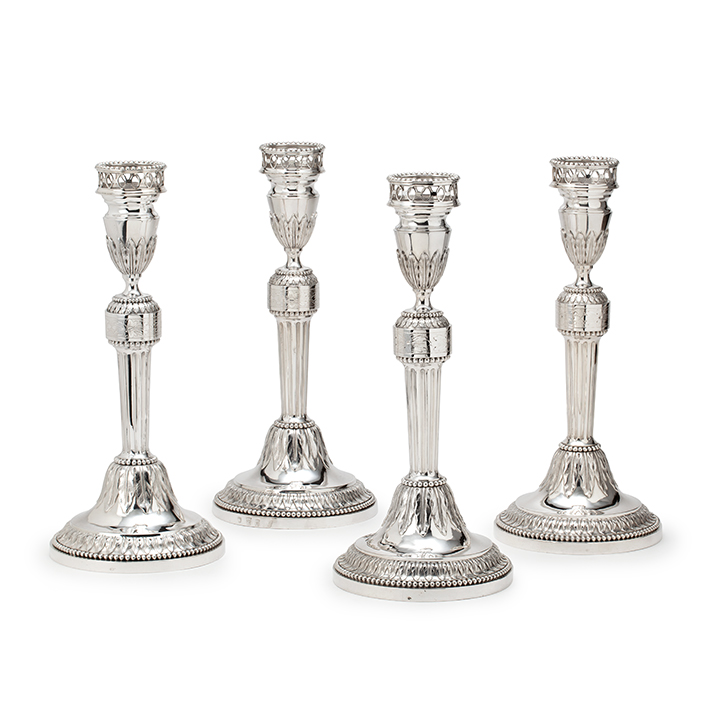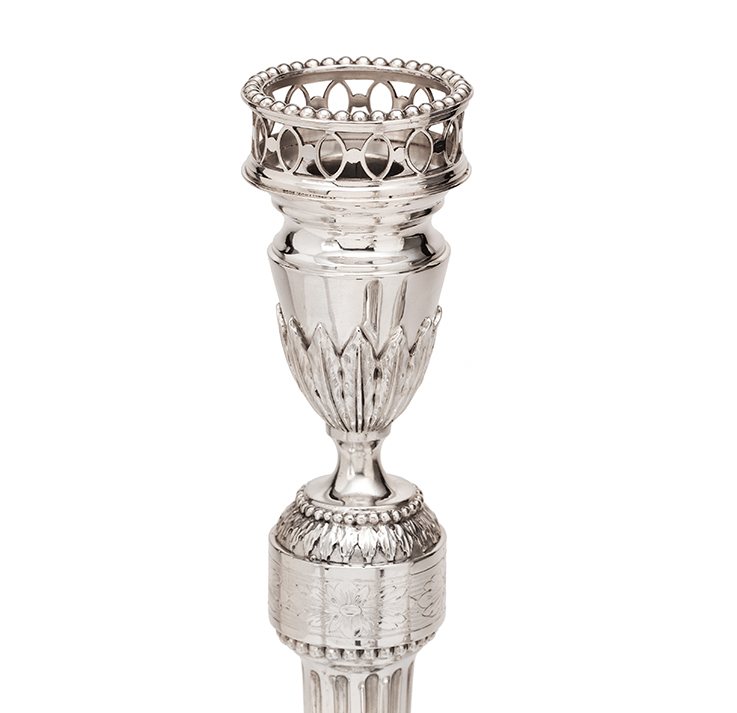
Dutch silver candlesticks
About This Project
Set of two pairs of Dutch silver candlesticks
Rudolph Sondag
Rotterdam, 1787 and 1788
2578 grams in total; 29,5 cm high
Each candlestick on a circular high-domed base with stiff leaves and a beaded and stiff leaf border, rising to a tapering fluted stem with beaded knob, engraved with a band of flower heads, surmounted by an urn-shaped socket applied with stiff leaves; detachable nozzle with gallery pierced with ovals and beaded border. Fully marked on the underside of the bases. Also struck with the control mark ‘a crowned O’ for 1807.
The silversmith
The maker’s mark ‘a sun’ (in various variants) belonged to the Rotterdam silversmith Rudolph Sondag (1726-1812). He was born on 4 February 1726, the son of Jan Sondag and Barbara Boelhorst. In 1747 he married Johanna van Essen (1725-1799), also from Rotterdam. According to a booklet with names of members of the Rotterdam silversmiths’ guild, dated 1806, Rudolph (Rudolphus) Sondag had become a master in the silversmiths’ guild in 1746 and stopped working in 1812. His name and his maker’s mark also appeared on a list of 1768, number 29. He lived with his family in Rotterdam, moving from Kipstraat to Westerwagenstraat and Hoogstraat. Rudolph Sondag reached the ripe old age of 86, and was buried on 19 November 1812. His son Johannes Petrus Sondag, maker’s mark IPS in oval, worked as a silversmith in Rotterdam from 1784 till circa 1801, the year he went bankrupt. In 1813 he picked up his profession as a silversmith again.
Rudolph Sondag left behind a large and varied oeuvre, spanning several style periods. As far as we know, no silver objects by him have survived from his earliest period as a silversmith. He might have earned a living by drawing, designing, sculpting and engraving then. The earliest object known by him, dated 1754, is a tabernacle embossed with the scene “The Mount of Transfiguration”. Other early silver objects date from 1760, a tobacco box and an inkstand, which stylistically can be considered to belong to the Louis XV style period, because of the rocaille ornaments. The baskets made by Rudolph Sondag in 1763 and 1765 are of oval form, but display flower, leaf and rocaille ornaments, according to the fashion of the time. It was not until after 1775 that his silver objects became more rigid in shape and Sondag exchanged the Rococo style for the Neoclassical style.
It is remarkable that a relatively large amount of Rudolph Sondag’s work has been preserved, in contrast to that of his Rotterdam fellow guild members. Sondag probably had a large studio with apprentices and journeymen, which allowed the ‘production’ to be large. He was not only a silversmith, but also a smart entrepreneur. Unfortunately, the archives relating to the Rotterdam silversmiths have largely been lost during the Second World War. However, some notarial archives in the Rotterdam Historical Archive are still available. Furthermore, we can conclude from the surviving works that Rudolph Sondag not only had private patrons, but also received important ecclesiastical commissions.
For example, in 1761 he made a ciborium (a large, lidded chalice to store the hosts), depicting several saints, and in 1764 a monumental lectern in the shape of an eagle. Both liturgical objects are decorated with rocaille ornaments. Of his secular works, the funeral shields he made in 1782 for the Guild of Sack Bearers and the four special four-light candelabra from 1786 that are placed on elephant figures should be mentioned. The latter profane works were undoubtedly commissioned and executed in neoclassical style. The notarial archives show that Rudolph Sondag not only made and sold silverware, but also bought silverware for large sums of money and that he was also asked to value silverware. It can be concluded that this versatile eighteenth-century silversmith from Rotterdam could compete with his Amsterdam colleagues at the time. Together with the Utrecht silversmith Nicolaes Verhaer, Rudolph Sondag was one of the most important ‘large workers’ in the 18th century.
For more information, click here




